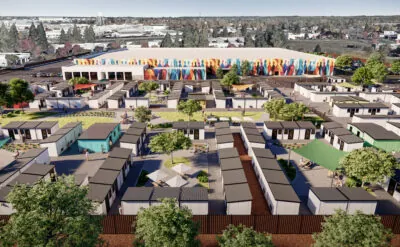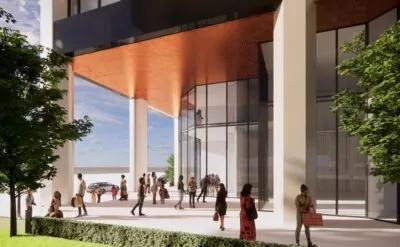The United Nations Sustainability Development Goals (UNSDGs) hold immense relevance for building resilient communities. These Goals provide a comprehensive framework that addresses the urgent global challenges of our time. To emphasize our pivotal role in achieving specific Goals, we called upon our team members from across the globe to share their insights and strategies, uniting our efforts to shape a more sustainable and resilient future for all.
Brian Gerstmar, President & CEO – Artificial Intelligence
The advent of AI arrives with impeccable timing when humanity needs us most. The challenges we face are monumental: climate change, a housing crisis, vulnerable populations and human rights to name a few. In this pivotal juncture, architects are emerging as the unsung heroes, poised to make a profound impact to help shape a better future. AI is stepping onto the word stage in ways we never imagined, helping guide the evolution of the built environment. AI-powered Digital Twins from the design and construction phase are providing access to real-time data from building systems, performance and utilization through visualization and analysis tools to create truly sustainable smart buildings and communities.
Blake Jackson, Director, Sustainability – Urban Heat Mitigation
Climate change is an all-encompassing force that knows no geographic boundaries. All locations – hot and cold, urban and rural, and inland or coastal – will be impacted. Increasing urbanization is only accelerating this problem, due to the further destruction of natural habitats, which have an innate capacity to regulate temperatures. This phenomenon known as the urban heat island effect will only intensify since our cities are designed to trap, rather than dissipate, solar radiation. We challenge our global community of practicing architects to design with the purpose of cooling our urban environments, utilizing place- and nature-based solutions that support sustainability, resiliency, wellness and equity.
George Sorich, Vice President, Residential – Urban Regeneration
With the growth of urbanization, it is projected that 70% of the global population will live in cities by 2050. Sustaining this growth, while tending to the health of citizens, cities and the planet, will need a multi-disciplinary approach. This includes urban regeneration strategies supporting 15-minute neighborhoods, the repositioning of existing building stock into mixed-use residential focused developments, and the vertical densification of city centers around the globe. These strategies yield sustainable benefits by reducing urban sprawl, utilizing existing infrastructure and promoting efficient land use. They also create social value through affordability, diversity, and civic pride, while creating economic viability with vibrant urban centers, increasing the tax base and leveraging existing municipal incentive programs.
Robin Stewart, Director, UK – Decarbonization
Decarbonization isn’t solely the responsibility of building engineers. Architects and engineering need to work together to lead the way, educating building owners to help achieve collective carbon reduction goals. We need to repurpose existing buildings wherever possible to reduce the embodied carbon associated with construction. An architecture led ‘fabric first’ approach is vital for both new and existing buildings to improved air tightness in combination with improved thermal performance. Intelligent design must consider orientation and highly efficient wall to floor ratios, while using new technologies to drive innovation for more efficient ways for heating and cooling, such as connecting buildings through sustainable heat networks.
John Baird, Managing Director – Modern Methods of Construction
Modular design is gaining momentum in the built environment as an approach to Modern Methods of Construction (MMC). The housing crisis and climate crisis are two significant factors that are accelerating off-site manufacturing of modular components. The built environment is one of the most significant CO2 emitting sectors, responsible for 40% of annual global emissions: 27% from energy use (operational carbon) and 13% from materials and construction activities (embodied carbon). Modular construction holds immense potential to reduce both, as well as creating high performance buildings. In the future, modular construction could encourage full Cradle-to-Cradle results with entire buildings erected, disassembled and reconstituted under the same roof.
Frank Panici, Vice President, Health Sciences – Architects as Integrators
To create viable and resilient communities, we must embrace the role of “integrators”. We are not mere designers but storytellers building a narrative, weaving the story of the community in every building we design. We must harvest and assemble diverse aspects such as culture, environment and functionality-into a harmonious whole. Each design should form part of the ongoing tale of the community’s evolution, building chapter upon chapter ensuring that the design fits together and makes sense – holding the community together. It is our responsibility to foster connections, strengthen communities against challenges, and introduce purposeful narratives into our designs which will contribute to the resilience and vitality of the places we shape – and into resilient communities.
Russell Baxter, Director, Design, UK – Creating Community
For a community to survive, be healthy and prosper, it must be viable. Architects are well placed to assist in the creation of viable communities. The key is listening from inception to completion. Listening to the community group while developing the brief; listening to end users regarding how the building should function; listening to local community groups regarding how they might adapt and grow, given the right space; and listening to the wider community to establish what they actually want. Listening and learning what the community is and needs will deliver great architecture that will support resilient communities.
Rachel Turner-Lauck, Vice President Operations – Equity in Design
Embracing Equity, Diversity and Inclusion in the design process and design conversation can be as straight forward as implementing accessible design standards within a project. It can also be much more complex, such as designing with an understanding of the social impact of a building on the users and occupants; on those working in construction and installation; on the neighborhood and surrounding community; and on the people involved in the building-material supply chain. To design resilient communities, social equity should be at the heart of the process as there is a natural overlap with the sustainability and the green building movement.
Manoj Mistry, Principal, Public Buildings and David Fortin, David T. Fortin Architect Inc. – Reconciliation
Incorporating Indigenous principles into architecture and engineering goes beyond mere design aesthetics. It represents a commitment to respecting the land, its inhabitants, and the cultural heritage of Indigenous communities, where integrating these principles, architecture and engineering can contribute to sustainable, low-impact designs that respect the land and its resources. This approach will foster respect for the ancestral wisdom of Indigenous communities and promote inclusivity in our professional practices.
Aligning with Indigenous principles in architectural and engineering services inherently supports the Canadian government’s commitment to meet UNDRIP (United Nations Declaration on the Rights of Indigenous Peoples) resolution 92. This resolution highlights the importance of recognizing and respecting Indigenous cultures, traditions, and institutions in all sectors, including architecture and engineering. By embracing Indigenous principles, Canada advances reconciliation efforts by acknowledging the rights and perspectives of Indigenous peoples.
In architecture and engineering, meaningful reconciliation is more than incorporating Indigenous principles and design aesthetics. It is important to include Indigenous voices and agency – meaning collaborations, economic reconciliation, and respectful community engagement. Reconciliation can only thrive when Indigenous peoples have a leading voice alongside the rest of Canadians.
A Pivotal Industry
Today, architects are not merely designers of buildings but architects of change. We’ve become pivotal change-makers in our place-making process. Together, we forge ahead as stewards of progress, weaving resiliency, innovation and inclusivity – aligned to UNSDGs – into the very fabric of the built environment.



